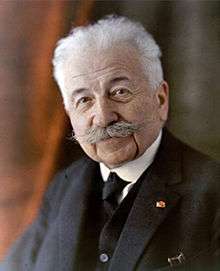Auguste Lumière
Auguste Marie Louis Nicolas Lumière (19 October 1862 – 10 April 1954)[1] was a French engineer, industrialist, biologist, and illusionist. During 1894–1895, he and his brother Louis invented an animated photographic camera and projection device, the cinematograph, which met with worldwide success.
Auguste Lumière | |
|---|---|
 | |
| Born | Auguste Marie Louis Nicolas Lumière 19 October 1862 |
| Died | 10 April 1954 |
| Occupation | Engineer |
| Relatives | Louis Lumière (brother) |
| Engineering career | |
| Projects | cinematograph |
| Awards | star on the Hollywood Walk of Fame (1960) |
Lumière was born in Besançon. He attended the Martinière Technical School and worked as a manager at the photographic company of his father, Claude-Antoine Lumière. He was invited to attend a demonstration of the Kinetoscope invented by Thomas Edison, which inspired his and his brother's work on the cinematograph.[2] The brothers screened their first film using this device in December 1895, and following the success of this initial venture opened a number of cinemas worldwide. However, Auguste was skeptical of the potential of the device, remarking "My invention can be exploited... as a scientific curiosity, but apart from that it has no commercial value whatsoever".[3]
After his work on the cinematograph Lumière began focusing on the biomedical field, becoming a pioneer in the use of X-rays to examine fractures. He also contributed to innovations in military aircraft, producing a catalytic heater to allow cold-weather engine starts.[3] He died in Lyon, aged 91.